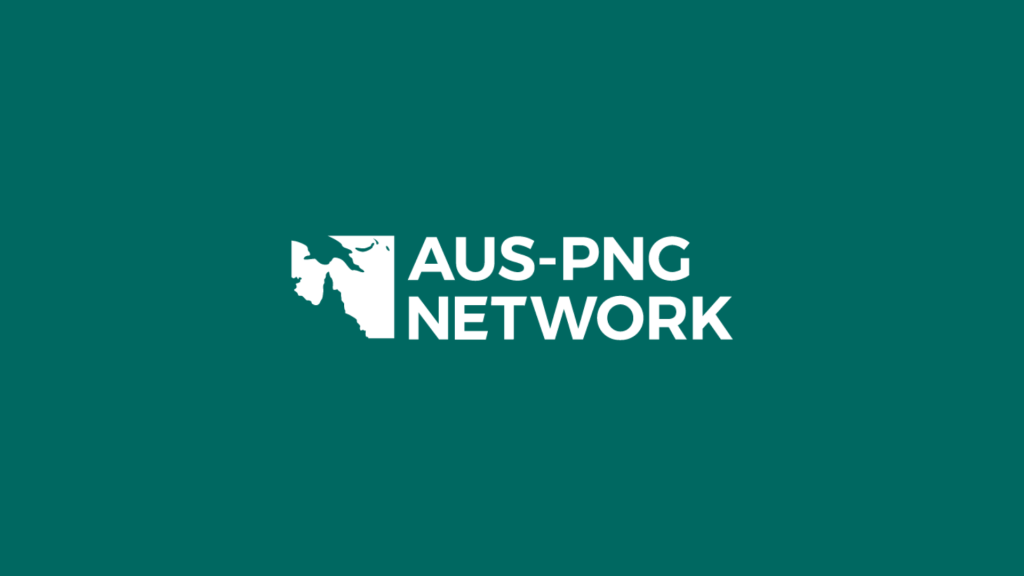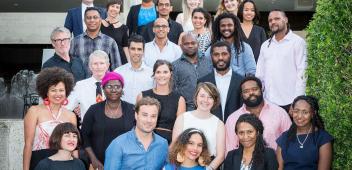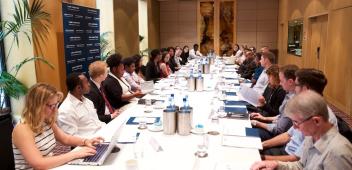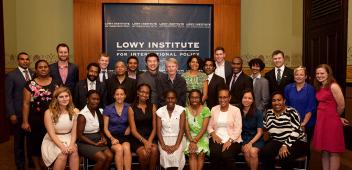2014 Emerging Leaders Dialogue
In this Report, the Lowy Institute’s Melanesia team summarises the outcomes of the second annual Australia-Papua New Guinea Emerging Leaders Dialogue. This Dialogue set a new standard for frank and broad-ranging discussion between young leaders from diverse fields in both countries. Food security, access to services and justice, the growing importance of social enterprises, and the prospects for Bougainville were key focus areas for the discussion. Connections made through the Dialogue are enabling exciting new collaborative work.

Key Findings
- The agriculture sector struggles to attract young talent and government attention in both Australia and PNG. This has flow-on effects for national food security and health in PNG and limits diversity and innovation in Australia.
- The growing popularity of entrepreneurship as a tool to create positive social change creates opportunities for greater collaboration between young Australians and Papua New Guineans. This could be enabled by better utilising the social media tools already available in both countries.
- The consequences of Bougainville’s upcoming referendum are not well understood among the younger generation of Papua New Guineans. Given the significance for our region of a vote for independence in Bougainville, greater discussion and education about Bougainville’s future is warranted.
Executive Summary
The Lowy Institute for International Policy convened the second annual Australia-Papua New Guinea Emerging Leaders Dialogue in Sydney under the auspices of the Australia-Papua New Guinea Network from 1 to 4 December 2014.
The Dialogue brought together twenty leaders from both countries to discuss common challenges and build lasting professional connections. The young leaders came from diverse backgrounds working in sectors such as youth work, law and justice, agriculture, health, education, the military, finance and tourism. Their discussion focused around the central themes of sustainability, entrepreneurship and international engagement. Participants also had a constructive and informed discussion on contemporary challenges — including the future of Bougainville, Indigenous Australians’ access to services and justice, Australian aid, and asylum seekers in Manus.
The Dialogue was chaired by Jenny Hayward-Jones, Program Director, Melanesia at the Lowy Institute and Serena Sumanop, Executive Director, The Voice Inc., Papua New Guinea.
Key recommendations from the participants were:
- Developing an online teaching resource for primary and high school students in Australia and Papua New Guinea focused on the 40th anniversary of independence to assist in understanding our joint history. This could be coordinated by the Australia-PNG Network and made available via its website.
- The introduction of an annual Emerging Leaders Award for an Australian or Papua New Guinean who has made an outstanding contribution to deepening ties between our two countries. This award could be presented on behalf of the Australian and Papua New Guinean Foreign Ministers at the Emerging Leaders Dialogue and involve opportunities for high-level meetings and public presentations.
- Tour operators on the Kokoda Track could work together to integrate PNG and Australian groups doing the track. This could be an opportunity to encourage Australian Indigenous youth organisations to work with counterparts in Papua New Guinea.
- The Australian Government could contribute to constructive discussions on the future of Bougainville by facilitating opportunities for young people from all over Papua New Guinea to debate issues around the referendum on independence.
- Communities in Australia and Papua New Guinea face similar challenges with the prevalence of lifestyle diseases, such as diabetes and obesity. Organisations and individuals in Australia with expertise in successful public health awareness campaigns, dietary advice and service delivery in rural and remote areas could pursue partnerships with community and government organisations in Papua New Guinea.
- Papua New Guinea’s rapidly growing urban areas are putting a strain on existing infrastructure. Papua New Guinea’s towns could benefit from Australian experience in town planning. Partnership and interaction through mechanisms such as sister-city relationships would help develop appropriate and practical town plans improving sustainability and quality of life.
- Australian assistance in the agriculture sector should aim to attract investment in initiatives relating to smallholder agriculture, with particular attention to promoting a more balanced diet, crucial for the health and economic productivity of Papua New Guinea. Some examples of specific focal points include preserving local foods of nutritional benefit, maintaining general crop diversity, encouraging inland fisheries as a source of protein for rural communities, and creating business models that support better downstream processing of agricultural produce.
- A professional exchange program that enabled Australians to take up work placements in Papua New Guinea and Papua New Guineans to take up work placements in Australia at a mid-career level for up to 12 months. This has the potential to deliver immediate results by boosting the business acumen of individuals and deepening professional and people-to-people links. Some multinational companies such as banks and resources companies already do this well. Expansion to other sectors including agriculture, tourism, higher education, journalism and state-owned enterprises would need some government backing to encourage commitment from the private sector and enable appropriate visa arrangements. This initiative would be consistent with the rationale behind the Australian Government’s New Colombo Plan and the Australia Awards scheme.
- A private sector-backed business incubation initiative that brings together high-level mentoring, access to seed funding, and shared information to case studies on relevant successful start-up companies in both countries. This should be targeted at young Papua New Guineans and Indigenous Australian youth, particularly women, without access to tertiary education to encourage them to take on the risk of starting a small business.
Introduction
The Dialogue set a new standard for frank and broad-ranging discussions between young leaders from both countries. The Australian participants developed a strong appreciation of the challenges and opportunities facing our nearest neighbour. The Papua New Guinean participants gained new insights into domestic debates in Australia on issues such as health, education, environment, and Indigenous inclusion. A number of the participants are already discussing professional and community projects they can collaborate on to leverage expertise for more effective results. They were enthusiastic about continuing engagement and building professional relationships, particularly in the fields of small business, agriculture and health.
The following provides a summary of the discussion at the Dialogue. The report is written on a non-attributable basis. A list of the participants and observers involved in the event is attached as an annex.
Key discussion areas
Food security
Food security was an increasingly important issue for both Papua New Guinea and Australia. While rural Papua New Guineans could live off subsistence farming, in the long term there was a risk that Papua New Guineans may not have the capacity to feed themselves. Subsistence farmers produced only enough crops to sell in local markets. The majority of the urban population of Papua New Guinea is already reliant on imported processed foods. High population growth meant the nation would be dependent on imported foods. Like many developing countries, Papua New Guinea lacks the negotiating power to ensure poor quality foods are not dumped in its market.
In Papua New Guinea there is the added challenge of a popular perception of traditional foods being inferior to processed and imported Western-style foods. Imported foods were associated with a middle-class lifestyle. The change in diet had a devastating effect on the health of the Papua New Guinea population; large numbers were suffering from non-communicable diseases, such as diabetes and obesity. Efforts should be focused on increasing the prestige of locally produced foods and preserving traditional food systems knowledge. The rising cost of non-communicable diseases makes this an economic as well as a health issue. The Papua New Guinea government appeared to be changing its approach and had launched a National Strategy for Responsible Sustainable Development in 2014.
Supporting small-scale agriculture
Papua New Guinea had the capacity to develop smallholder farms and sustain its population with traditional foods. A region like the Markham Valley in Papua New Guinea could feed the nation. But there was insufficient investment in the agriculture sector. Government attention was focused primarily on the resources sector. Young Papua New Guineans were encouraged to move from rural to urban areas to obtain low-paid jobs rather than work in agriculture where they could earn much more from crops such as coffee beans. Similarly in Australia, careers in agriculture were not appealing to young people. More investment in diversified farming and in downstream processing would help increase the value of agriculture in both countries.
In Australia there has been a growing trend towards macro agriculture. But experience in developing countries showed that investment in micro agriculture was more productive for them. For example, India was the biggest producer of dairy and 80 per cent of dairy products were consumed within one kilometre of the cow that produced them. Access to finance and insurance was important for smallholders. This was challenging in rural areas but mobile phone technology could be harnessed to offer access to capital and insurance in remote and rural areas.
Youth Engagement
Another important issue for both countries was youth engagement. For Australia this was central to tackling law and justice problems, particularly in Indigenous communities. An economic argument could be used to put pressure on government to re-evaluate their approach. The costs associated with incarcerating people were much higher than the costs of early intervention or programs to support young Indigenous people through school. Participants highlighted the effectiveness of the arts in this process. Through the use of mediums such as theatre, Indigenous youths were able to communicate their experiences of the justice system with the wider community and with law enforcement agencies. This highlighted the sometimes unfair prejudices Indigenous people faced and was able to spark a dialogue between the police and Indigenous communities on the issues in their relationship.
Sport could also be a very effective tool to engage young people and in the process impart important values, increase self-esteem and provide good role models and an alternative support network. In Indigenous communities in Australia sporting programs helped to inject pride back into the young people’s lives. By focusing on what they can do, rather than using the language of victimhood, programs like these saw huge successes in lowering the rates of crime in some Indigenous communities. The challenge was to scale these programs to achieve positive effects in other communities.
The Papua New Guinea participants greatly valued the input of the Indigenous participants, recognising the many shared challenges their communities faced. They also saw success with programs that used sport as a means of attracting young people’s attention to broader issues, for example environmental damage to coastlines from household rubbish. In Papua New Guinea there were not the same opportunities for young athletes to reach professional levels of sport and participants expressed their desire to see this change.
Participants from both countries acknowledged the importance of clear communication and cooperation between all of the parties working with young people. Schools were recognised to be vitally important but they must work with service providers and parents. There were many NGOs doing important work in this space, however participants were aware that there could be duplication of work between some.
Health
The use of technology was viewed as central to innovation and entrepreneurship in the health sector. It transformed administration processes making health systems more cost-effective in Australia. Moving from paper systems to electronic systems made collecting and using health information far easier. An individual’s health records could be quickly accessed across Australia and many parts of the world. There were also many health applications for mobile devices that could be easily accessed, for example calorie and exercise trackers to assist in weight loss. Creative online approaches to mental health also had a big impact for young Australians. Online platforms that gave them access to medical information and professionals were a powerful way for young people to take ownership of their health, particularly with the sensitive issue of mental health.
Technology was not as advanced in Papua New Guinea’s health sector. Mobile technologies had improved data collection methods in the field. There were also technologies in the pilot phase for surveillance of infectious disease outbreaks. The responsibility for health service delivery was gradually shifting from government to the private sector and non-government organisations. Large mining companies like Oil Search had become big players in health services because they had better financial systems and capacity to roll out large-scale programs targeting HIV and malaria. The Papua New Guinea government could replicate these kinds of public-private partnerships with other health service delivery initiatives and in this way capitalise on technological advancements.
Social entrepreneurship
Participants discussed new social entrepreneurship as a means of tackling problems, such as those in Papua New Guinea’s health sector, with creative business approaches that were economically viable. This required looking for gaps in markets and creating projects to fill those gaps in ways that would bring profit and social returns. For example in South Africa, an innovative insurance scheme which offered life insurance to people living with HIV contingent on them adhering to medical treatment was resulting in these people being fitter and living longer and thus making a positive contribution to society. Innovation is not just about finding new solutions; it is about improving on what already works and making current systems more sustainable. It requires collaboration across different sectors. However, there was a cautionary note from participants during this discussion; in the attempt to find the solution to problems of inequality and poverty people can overlook the fact that diverse contexts require diverse solutions.
It is difficult to involve all sectors of society in programs that aim to promote entrepreneurship. In Australia, there were targeted programs that supported Indigenous small business owners in the first three years of running their businesses. In Papua New Guinea there were programs developed specifically for women and young people in business. Only one per cent of the Papua New Guinea population was actively involved in formal business. There are significant strains on the Papua New Guinea economy and the population is quite risk-averse, so it was difficult to inspire people to become entrepreneurs.
There were other emerging economies that had successfully built a culture of enterprise from which Papua New Guinea could draw lessons. In Kenya the ihub is an enabling and support mechanism for entrepreneurs in IT (http://www.ihub.co.ke/). There were also programs like Endeavour (http://www.endeavor.org/), a global incubator program for start-ups. In Australia, entrepreneurs could get support for their projects through formal programs with universities and the government but there were also avenues to find informal support, like co-working spaces and technology innovation groups accessible through Meetup platforms.
Encouraging young people to enter business
In Papua New Guinea there were also new programs being launched to foster entrepreneurship amongst young people. This was an essential project because of the lack of opportunities for young people in Papua New Guinea to continue to higher education or gain formal employment after high school. There were 24 000 students graduating from high school and only 4 000 places at universities in Papua New Guinea. However, it was difficult to inspire young people to start their own businesses because of the risks that came with that. Most Papua New Guineans had an obligation to help support their extended family and wantok networks, which made them more inclined to take on low-paid but secure jobs.
Participants proposed building on the business incubation programs that were already in existence by creating a business exchange program between PNG and Australia. The program would seek to promote small business as an alternative form of employment for young people by providing them with educational resources to see how other small businesses have been successful and selecting participants to travel to each other’s countries to experience how business works there. Another element of this program would be high-level mentoring from key figures of large corporate companies. It could also be replicated for people in middle management positions in state-owned enterprises who would learn a lot from the experience and are already in decision-making positions so could begin to implement what they had learned immediately. Participants noted that Papua New Guinea’s state-owned enterprises, because of their important national role in service provision and their own particular challenges merited this kind of assistance. This would require the support of the Australian and Papua New Guinean governments and the private sector.
Strategic Importance of Papua New Guinea for Australia
In the session on International Engagement participants discussed the varied nature of the Australia-Papua New Guinea relationship as well as the two countries’ relations with their neighbours. The participants recognised the immense strategic importance of Papua New Guinea to Australia. The strategic geography of the region placed Papua New Guinea on the air and maritime approaches to Australia. This made the continued stability and territorial integrity of Papua New Guinea a vital interest of Australia’s. The Australian Government continued to provide extensive support to Papua New Guinea’s security through over AUD 11 million of funding a year to the Defence Cooperation Program and extensive assistance to the Royal Papua New Guinea Constabulary through the Australian Federal Police. These programs were essential to increasing the professionalism and capacity of these organisations. However, there needed to be more accountability and transparency regarding the appointments of senior commanders and greater commitment to political impartiality within the security forces.
Tourism
The participants identified shared history as a key element in relations between Australia and Papua New Guinea. The Kokoda Track continued to attract immense interest from Australians and thousands walked the track every year. This had important benefits for rural communities in the area as visitors, tour operators and non-government organisations such as the Kokoda Track Foundation delivered income and social programs. However, the way tourism around the track operated does not fully recognise the Papua New Guinea story of Kokoda or Papua New Guinea culture. More and more Papua New Guineans were walking the track and they could be integrated with the Australian groups. The expansion of the National Museum of Papua New Guinea and the Papua New Guinea in WWII Oral History project (http://ips.cap.anu.edu.au/cap-events/2014-10-14/recalling-war-png-wwii-oral-history-project#.VJNdQV4DQA) would also deepen the experience. Other new tourism developments, such as Carnival Australia’s cruises, were giving Australians an experience of Papua New Guinea and providing some training and infrastructure for communities involved. Papua New Guinea entrepreneurs, with support and access to capital could take advantage of this growing market to increase the economic benefits of tourism to communities.
Manus Island – Regional Processing Centre
Participants also reflected on some contentious areas of the Australia-Papua New Guinea relationship. Papua New Guinea participants raised the damage they considered the Regional Processing Centre on Manus had done to Papua New Guinea’s image on the world stage and in Australia. The Australian media had portrayed Manus as a “hell hole” which was completely at odds with the lives of the people of Manus. Tensions between residents and asylum seekers in Manus had been exacerbated by a lack of understanding and communication. There was also a perception among some Papua New Guineans that the services and assistance were being directed at the asylum seekers and contractors rather than the people of Manus province. Evidence on the ground showed that this was not necessarily the case and that the assistance from Australia was delivering a number of direct benefits to the residents of Manus. Companies based in Morobe province were also benefiting from contracts related to the Refugee Resettlement Arrangement.
West Papua
The regional processing centre had also pushed the Papua New Guinea government and people to re-examine the status of asylum seekers in Papua New Guinea. This was most relevant to the thousands of West Papuans residing in Papua New Guinea who now had the opportunity to apply for refugee status. There was a general lack of awareness about the plight of West Papuans in Australia. The ability of the Papua New Guinea and Australian governments to engage on the issue was complicated by important bilateral relations with Indonesia.
Bougainville
The participants discussed issues surrounding Bougainville, its peacebuilding experience and its upcoming referendum on independence between 2015 and 2020. Bougainville faced many of the same challenges as the rest of Papua New Guinea in terms of sustainable development but the history surrounding the Panguna mine and the conflict made the issue of how natural resources are used more controversial. Reconciliation between groups within Bougainville and with Papua New Guinea was crucial for social cohesion and peacebuilding. Some of the Papua New Guinean participants were sorry that there was a desire for independence in Bougainville. They noted that few young people in Papua New Guinea were aware of the history of the Bougainville conflict and had not engaged in discussions about the implications of independence. The Australian participants, for their part, noted that there was very little awareness of Bougainville amongst young people in Australia. Participants believed that Australian organisations could play a constructive role in helping to provide platforms for more conversations and awareness about Bougainville within Papua New Guinea.
Acknowledgments
The Lowy Institute appreciates the generous support of the Australian Department of Foreign Affairs and Trade for the Australia-Papua New Guinea Network and the annual Australia-Papua New Guinea Emerging Leaders Dialogue.



